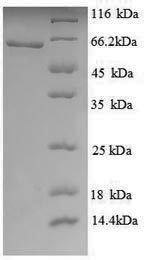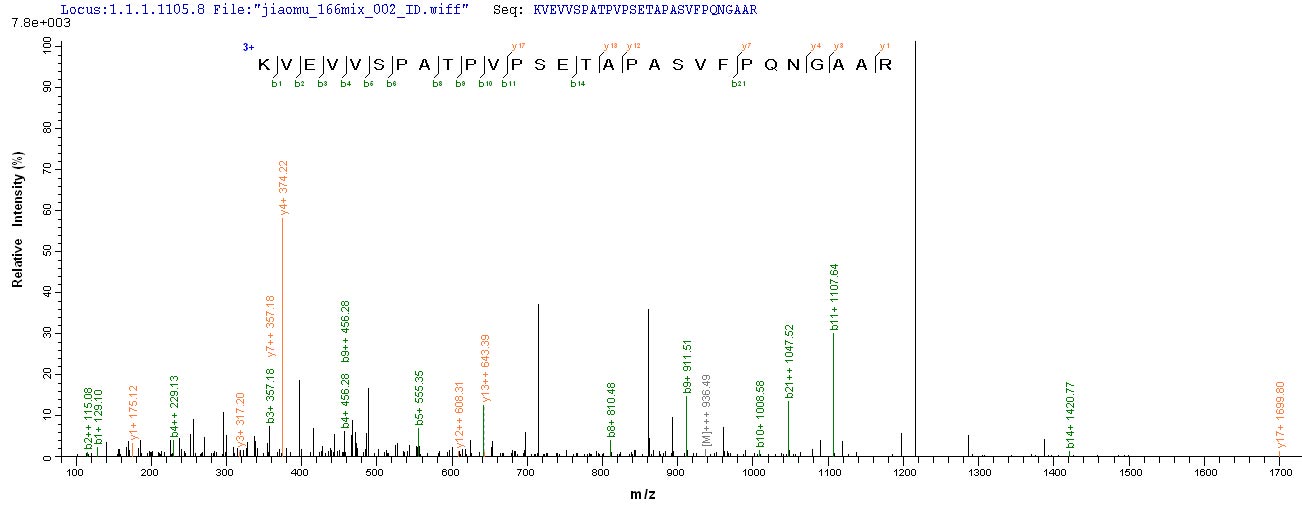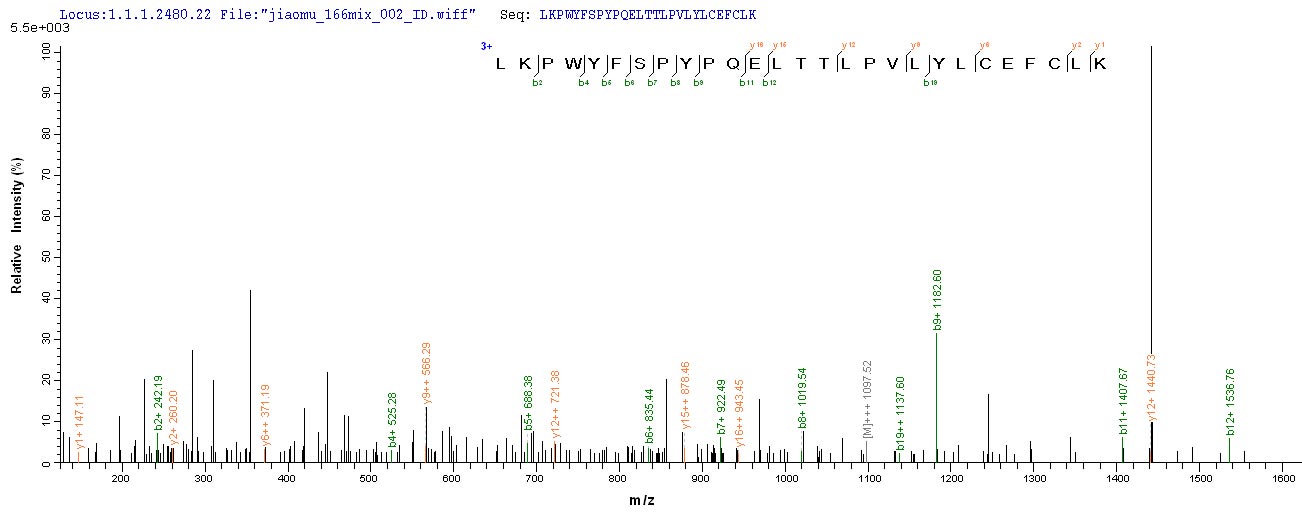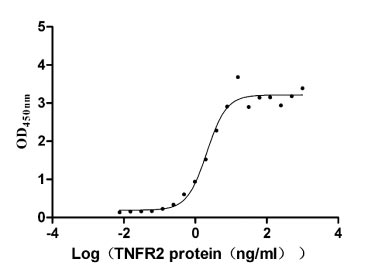Recombinant Human Histone acetyltransferase KAT5 (KAT5), partial
In Stock-
货号:CSB-RP178494h
-
规格:¥1344
-
图片:
-
(Tris-Glycine gel) Discontinuous SDS-PAGE (reduced) with 5% enrichment gel and 15% separation gel.
-
Based on the SEQUEST from database of E.coli host and target protein, the LC-MS/MS Analysis result of CSB-RP178494h could indicate that this peptide derived from E.coli-expressed Homo sapiens (Human) KAT5.
-
Based on the SEQUEST from database of E.coli host and target protein, the LC-MS/MS Analysis result of CSB-RP178494h could indicate that this peptide derived from E.coli-expressed Homo sapiens (Human) KAT5.
-
-
其他:
产品详情
-
纯度:Greater than 90% as determined by SDS-PAGE.
-
基因名:KAT5
-
Uniprot No.:
-
别名:60 kDa Tat interactive protein; 60 kDa Tat-interactive protein; cPLA(2) interacting protein; cPLA(2)-interacting protein; cPLA2; cPLA2 interacting protein; ESA1; Histone acetyltransferase HTATIP; Histone acetyltransferase KAT5; HIV 1 Tat interactive protein; HIV 1 Tat interactive protein, 60kDa; HIV-1 Tat interactive protein; HTATIP; HTATIP1; K(lysine) acetyltransferase 5; K-acetyltransferase 5; KAT5; KAT5_HUMAN; Lysine acetyltransferase 5; PLIP; Tat interacting protein, 60kDa; TIP; Tip60
-
种属:Homo sapiens (Human)
-
蛋白长度:Partial
-
来源:E.coli
-
分子量:62.4kDa
-
表达区域:3-513aa
-
氨基酸序列EVGEIIEGCRLPVLRRNQDNEDEWPLAEILSVKDISGRKLFYVHYIDFNKRLDEWVTHERLDLKKIQFPKKEAKTPTKNGLPGSRPGSPEREVPASAQASGKTLPIPVQITLRFNLPKEREAIPGGEPDQPLSSSSCLQPNHRSTKRKVEVVSPATPVPSETAPASVFPQNGAARRAVAAQPGRKRKSNCLGTDEDSQDSSDGIPSAPRMTGSLVSDRSHDDIVTRMKNIECIELGRHRLKPWYFSPYPQELTTLPVLYLCEFCLKYGRSLKCLQRHLTKCDLRHPPGNEIYRKGTISFFEIDGRKNKSYSQNLCLLAKCFLDHKTLYYDTDPFLFYVMTEYDCKGFHIVGYFSKEKESTEDYNVACILTLPPYQRRGYGKLLIEFSYELSKVEGKTGTPEKPLSDLGLLSYRSYWSQTILEILMGLKSESGERPQITINEISEITSIKKEDVISTLQYLNLINYYKGQYILTLSEDIVDGHERAMLKRLLRIDSKCLHFTPKDWSKRGKW
Note: The complete sequence including tag sequence, target protein sequence and linker sequence could be provided upon request. -
蛋白标签:N-terminal 6xHis-tagged
-
产品提供形式:Liquid or Lyophilized powder
Note: We will preferentially ship the format that we have in stock, however, if you have any special requirement for the format, please remark your requirement when placing the order, we will prepare according to your demand. -
缓冲液:Tris-based buffer,50% glycerol
-
储存条件:Store at -20°C/-80°C upon receipt, aliquoting is necessary for mutiple use. Avoid repeated freeze-thaw cycles.
-
保质期:The shelf life is related to many factors, storage state, buffer ingredients, storage temperature and the stability of the protein itself.
Generally, the shelf life of liquid form is 6 months at -20°C/-80°C. The shelf life of lyophilized form is 12 months at -20°C/-80°C. -
货期:3-7 business days
-
注意事项:Repeated freezing and thawing is not recommended. Store working aliquots at 4°C for up to one week.
-
产品描述:
To prepare this Recombinant Human KAT5 protein, the recombinant DNA was required, which was generated by fusing the KAT5 gene with N-terminal 6xHis tag sequence. Once the recombinant DNA was amplified and purified, a protein expression system, E.coli, was needed for this KAT5 protein production. After purification, a premium KAT5 recombinant proteinwas obtained. According to SDS-PAGE, its purity turns out to be 90%+.
KAT5 (also called HTATIP or TIP60) is a gene encoding a protein named histone acetyltransferase KAT5 or 60 kDa Tat-interactive protein (short name is Tip60). The protein encoded by this gene belongs to a member of MYST acetyltransferase family and is an important component of an evolutionarily conserved complex, NuA4. KAT5 protein has been discovered multiple functions as transcriptional regulation factor together with or without nuclear receptors, such as activating or inhibiting downstreamgene expression; or acetylating a series of proteins to regulate their activities and stability. -
Datasheet & COA:Please contact us to get it.
相关产品
靶点详情
-
功能:Catalytic subunit of the NuA4 histone acetyltransferase complex which is involved in transcriptional activation of select genes principally by acetylation of nucleosomal histones H4 and H2A. This modification may both alter nucleosome-DNA interactions and promote interaction of the modified histones with other proteins which positively regulate transcription. This complex may be required for the activation of transcriptional programs associated with oncogene and proto-oncogene mediated growth induction, tumor suppressor mediated growth arrest and replicative senescence, apoptosis, and DNA repair. NuA4 may also play a direct role in DNA repair when recruited to sites of DNA damage. Component of a SWR1-like complex that specifically mediates the removal of histone H2A.Z/H2AZ1 from the nucleosome. Also acetylates non-histone proteins, such as ATM, NR1D2, RAN, FOXP3, ULK1 and RUBCNL/Pacer. Directly acetylates and activates ATM. Relieves NR1D2-mediated inhibition of APOC3 expression by acetylating NR1D2. Promotes FOXP3 acetylation and positively regulates its transcriptional repressor activity. Acetylates RAN at 'Lys-134'. Together with GSK3 (GSK3A or GSK3B), acts as a regulator of autophagy: phosphorylated at Ser-86 by GSK3 under starvation conditions, leading to activate acetyltransferase activity and promote acetylation of key autophagy regulators, such as ULK1 and RUBCNL/Pacer.
-
基因功能参考文献:
- Results show that KAT5 expression is decreased in prostate cancer (PCa) and correlated with shorter recurrence-free survival. PMID: 30142696
- Tip60 suppressed growth and metastasis throughout the progression of cholangiocarcinoma and identified the PI3K/AKT pathway as a dominant signal of Tip60. PMID: 30308494
- TIP60 is involved in several adipogenesis mechanisms through its interaction with three important proteins: PPARc, USP7, and GPR50. These actors act also in different processes of breast cancer development. PMID: 28873018
- These findings demonstrate the critical regulation of TIP60/p53 pathway in apoptosis upon metabolic stress and provide a novel insight into the down-regulation of TIP60 in tumor cells. PMID: 29174981
- Our data demonstrate for the first time that TIP60 through its MYST domain directly interacts with UHRF1 PMID: 29268763
- These results suggest that TIP60, in concert with other cellular factors, plays an important role in the regulation of the HBV chromatin structure by acting as a critical component of the intrinsic antiviral defense, which sheds new light on the regulation of HBV replication. PMID: 29321313
- Irreversible inhibition of USP7 results in durable downstream biological responses in cells, including down-regulation of Tip60 and consequent impairment of Treg suppressive function PMID: 29236775
- most HIF1A targets require either TIP60, the CDK8-Mediator complex, or both as coactivators for full expression in hypoxia. PMID: 27320910
- NOTCH1 inhibits activation of ATM by impairing the formation of an ATM-FOXO3a-KAT5 complex. PMID: 27524627
- Collectively, the data establish a hitherto unknown liaison among MDR1, BMI1 and TIP60 and provide mechanistic insights into cisplatin-induced MDR1 expression resulting in acquired cross-resistance against paclitaxel, doxorubicin and likely other anticancer drugs. PMID: 27295567
- TIP60-mediated growth suppression of HPV-induced cervical cancer is mediated in part due to TERT repression through Sp1 acetylation. In summary, our study has identified a novel substrate for TIP60 catalytic activity and a unique repressive mechanism acting at the TERT promoter in virus-induced malignancies. PMID: 29045464
- These findings reveal that Endoplasmic reticulum stress engages the GSK3beta-TIP60-ULK1 pathway to increase autophagy. PMID: 28032867
- TIP60 complex regulates bivalent chromatin recognition/modification by 53BP1 through direct H4K20me binding and H2AK15 acetylation. PMID: 27153538
- Studies suggest that lysine (K) acetyltransferase inhibitors (KATi) are important for providing personalized therapies. PMID: 27528742
- Thus Tip60 interacts with RNR and NME3 to provide site-specific synthesis of dNTP for facilitating DNA repair in serum-deprived cells which contain low levels of dNTPs. PMID: 26945015
- TIP60 acted downstream of UHRF2 to regulate H3K9ac and H3K14ac expression. PMID: 27743347
- Data provide evidence that the acetylation of H2AX at Lys5 by TIP60 is required for the (ADPribosyl) ation activity and the dynamic binding of PARP-1 to chromatin after the induction of DNA damage. PMID: 26976643
- Synthetic lethality screening identifies TIP60-dependent radiation sensitivity in the absence of BAF180. PMID: 27461052
- E1A 243R promotes association of MYC/MAX with the NuA4/Tip60 complex, implicating the importance of the MYC/NuA4 pathway in cellular transformation by both MYC and E1A. PMID: 27664947
- UV irradiation enhanced the binding of ATF3 to Tip60, knockdown of ATF3 expression decreased Tip60 stability, thereby impairing Tip60 induction by UV irradiation. PMID: 26994140
- KAT5 is significantly elevated in malignant pleural mesothelioma PMID: 26780987
- Data suggest the combination of histone acetyltransferase TIP60 and microRNA miR-22 as prognostic indicator of breast cancer progression. PMID: 26512777
- Colony-formation assays and soft agar assays show that gain of function of TIP60 or depletion of EDD1 in HPV-positive cervical cancer cells significantly inhibits cell growth in vitro PMID: 26234678
- We demonstrate for the first time that tumor suppressor Tip60 down-regulates cell adhesion and MT1-MMP expression and thereby invasion of glioblastoma cells PMID: 26464124
- TIP60 relocalization to the chromatin to acetylates histone H4K16 and prevents the binding of 53BP1 to its docking site.Impaired TIP60-mediated H4K16 acetylation accounts for the aberrant chromatin accumulation of 53BP1 and RAP80 in Fanconi anemia. PMID: 26446986
- Our results revealed a major role of the KAT5-ATM axis in protection of replicating chromatin against damage by the endogenous carcinogen FA. PMID: 26420831
- the acetylation-dependent NBS1 turnover by TIP60 on damaged chromatin restricts the dispersal of NBS1 foci from the sites of DNA damage. PMID: 26438602
- The stress-responsive gene ATF3 regulates the histone acetyltransferase Tip60 stability by promoting USP7-mediated deubiquitination of Tip60. PMID: 25865756
- Putative novel MYC interactors include components of the STAGA/KAT5 and SWI/SNF chromatin remodeling complexes PMID: 25452129
- TIP60 interacted with H3K4me3 in response to TNF-alpha signaling. PMID: 25560918
- Results establish that Tip60-T158 phosphorylation by p38 plays an essential role in stimulating Tip60 activity required for inducing the p53-PUMA pathway that ultimately leads to apoptosis in response to DNA damage. PMID: 25544752
- Tip60 is an important regulator of human papillomavirus genome amplification whose activity during the viral life cycle is controlled by STAT-5 and the kinase GSK3beta. PMID: 25673709
- HDAC3 promotes TIP60 ubiquitination and cytoplasmic localization and protects cells from apoptosis after DNA damage. PMID: 25301942
- These findings suggest that E2 recruits histone-modifying cellular proteins to the HPV LCR, resulting in transcriptional repression of E6 and E7. PMID: 25222147
- that KAT5 RNAi may result in cleaved casp9 upregulation through p38MAPK activation in Gallbladder carcinoma cells PMID: 24427328
- KAT5 and KAT6B regulate prostate cancer cell growth through PI3K-AKT signaling. PMID: 24294372
- Human melanoma patient samples and cell lines maintain p53 expression but PIASy and/or Tip60 are frequently lost. PMID: 23624367
- ZNF668 knockdown reduces Tip60-H2AX interaction and impairs ionizing radiation-induced histone H2AX hyperacetylation. PMID: 23777805
- degradation of Tip60 by the adenoviral early proteins is important for efficient viral early gene transcription and for changes in expression of cellular genes PMID: 23178490
- Tip60 differentially regulates the endogenous expression of the target genes by modulating the binding of ERbeta1 to the cis-regulatory regions. PMID: 23857583
- USP7 deubiquitinase activity is required for the stabilization of Tip60 in order to operate an effective p53-dependent apoptotic pathway in response to genotoxic stress. PMID: 23775119
- we conclude that PPAR agonists used in this work induces M1 macrophages polarization via inhibition of cPLA2 and the increase of aggressive microbicidal activity via reactive oxygen species (ROS) production. PMID: 23555077
- The role of Tip60 in mediating acetylation of p21 at its C-terminus is a novel and significant mechanism for post-translational regulation of cell-cycle progression. PMID: 23238566
- UHRF1 is a critical negative regulator of TIP60 and suggest that UHRF1-mediated effects on p53 may contribute, at least in part, to its role in tumorigenesis. PMID: 23677994
- study shows Tip60 plays an essential role in oncogenic ras-induced senescence; revealed a cascade of posttranslational modifications involving p38, Tip60 and PRAK, 3 proteins essential for ras-induced senescence; these modifications are critical for prosenescent function of Tip60 and PRAK PMID: 23685072
- Data indicate that ING5 associates with Tip60 (KAT5) to form a complex with p53. PMID: 23576563
- a novel pathway by which TIP60 and ThPOK synergistically suppresses Eomes function and IFNgamma production, which could contribute to the regulation of inflammation. PMID: 23609452
- RVBs are also required for heat stability of TIP60.com by a p400-independent pathway. PMID: 23297341
- tyrosine phosphorylation of KAT5 increases after DNA damage in a manner that promotes KAT5 binding to the histone mark H3K9me3; this triggers KAT5-mediated acetylation of the ATM kinase, promoting DNA-damage-checkpoint activation and cell survival PMID: 23708966
- Studies indicate histone acetyltransferase Tip60 as a potential therapeutic target for the treatment of prostate cancer. PMID: 23056207
显示更多
收起更多
-
亚细胞定位:Nucleus. Nucleus, nucleolus. Cytoplasm, perinuclear region. Note=Upon stimulation with EDN1, it is exported from the nucleus to the perinuclear region and UV irradiation induces translocation into punctuate subnuclear structures named nuclear bodies.
-
蛋白家族:MYST (SAS/MOZ) family
-
数据库链接:
HGNC: 5275
OMIM: 601409
KEGG: hsa:10524
STRING: 9606.ENSP00000340330
UniGene: Hs.397010
Most popular with customers
-
Recombinant Human Lymphotoxin-alpha (LTA) (Active)
Express system: Mammalian cell
Species: Homo sapiens (Human)
-
Recombinant Human Claudin-6 (CLDN6)-VLPs, Fluorescent (Active)
Express system: Mammalian cell
Species: Homo sapiens (Human)
-
Recombinant Human Tomoregulin-2 (TMEFF2), partial (Active)
Express system: Mammalian cell
Species: Homo sapiens (Human)
-
Recombinant Human C-C chemokine receptor type 8 (CCR8)-VLPs (Active)
Express system: Mammalian cell
Species: Homo sapiens (Human)
-
Recombinant Human Myosin regulatory light polypeptide 9 (MYL9) (Active)
Express system: Yeast
Species: Homo sapiens (Human)






f4-AC1.jpg)













